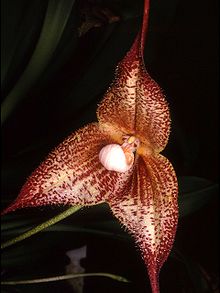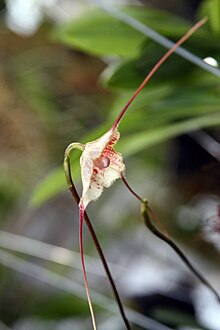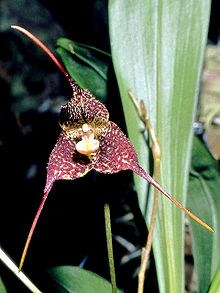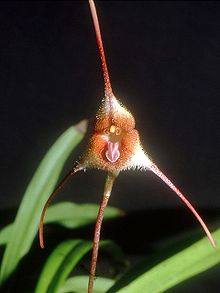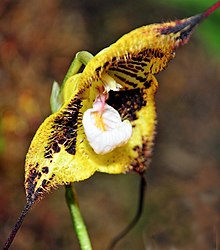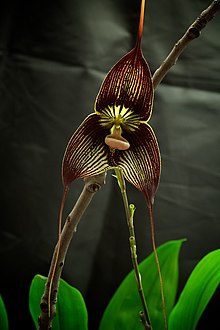Dracula (orchids)
| Dracula | ||||||||||||
|---|---|---|---|---|---|---|---|---|---|---|---|---|

Dracula ubangina |
||||||||||||
| Systematics | ||||||||||||
|
||||||||||||
| Scientific name | ||||||||||||
| Dracula | ||||||||||||
| Luer |
The genus Dracula belongs to the orchid family (Orchidaceae). It was classified as a separate genus by the botanist Carlyle A. Luer in 1978, before it was considered to belong to the Masdevallia genus ( Masdevallia Section Saccilabiatae ). It includes about 130 mostly epiphytic species that are native to southern Mexico to Peru . The name means little dragon and pays homage to the species Dracula chimaera described by Heinrich Gustav Reichenbach , as well as to the three outer petals that taper off like a tail and are reminiscent of flying bats (it is said that Luer has the publicity that he of the genus with this Name, later repented). The dark color and a matching smell were evidently created as an imitation of mushroom fruit bodies. The species of the genus are pollinated by flies that normally live on mushrooms.
description
The species of the genus Dracula are mostly epiphytic, more rarely terrestrial, herbaceous plants . They grow clumpy or with a creeping or ascending rhizome . The roots are surrounded by a velamen two or three layers thick . The shoot is covered by tubular lower leaves, at the end it has a single, thin, leathery leaf . The leaf is keeled along the midrib or provided with several longitudinal veins. The leaf shape is linear to elliptical, the leaf ends mostly pointed, the base of the leaf is narrowed like a stem. There are glandular hairs on both sides of the leaf.
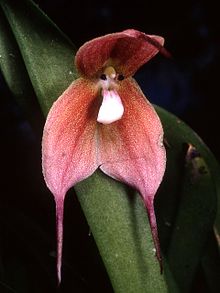
The racemose inflorescence usually contains several flowers that open one after the other , rarely it is single-flowered. The bracts of the flowers encircle the peduncle tubular. The ovary is hairless, the flowers are resupinated . The three outer bracts ( sepals ) are oval shaped, they end pointed or blunt and have a long extension. They have grown together to varying degrees. The lateral petals are small, elongated and have a gnarled texture. At the end they are pulled together into two warty pockets. The lip is spatulate and fleshy, it is articulately connected to the column . The column is semicircular in cross section, winged on the sides. It forms a "foot" on which the lip attaches. The stamen contains two laterally compressed pollinia , the stigma consists of one surface. Elliptical capsule fruits are formed.
distribution
The species of the genus Dracula are native to Central and South America, the range extends from southern Mexico to Peru. Most of the species are described from the countries of the Andean Belt. 72 species live in Colombia , 53 in Ecuador and only four in Costa Rica . The genus is missing z. B. in the Antilles , Venezuela , Bolivia and Brazil .
Most of the species are known from undisturbed tropical forests, only a few from secondary forests, they are mostly rare with a small distribution area. The genus is found at altitudes of 300 to 2,800 meters, but the greatest biodiversity is mainly in forests of the mountain rainforest level of around 1,500 to 2,500 meters.
ecology
The Dracula species are epiphytes in ever-damp forests, where they grow in a layer of moss or humus.
In some species, the flowers give off a mushroom odor. In Dracula chestertonii , the fragrances 1-octen-3-ol and 3-octanone were found, Dracula chimaera smells similar. The scent attracts flies as pollinators, which normally live on mushrooms. In individual cases, deceived flies even lay eggs. In the species Dracula lafleurii and Dracula felix , fruit flies (Drosophilidae) living on fungi were identified as pollinators. The pollination takes place here by a clamping mechanism of the column, which temporarily clamps the flies. An exception is Dracula sodiroi , which is pollinated by birds.
threat
The genera Dracula and Masdevallia are characterized by spectacular flowers in the otherwise inconspicuous sub-tribus Pleurothallidinae. This makes them popular with collectors and breeders, and some species are traded commercially. The existence of numerous species is threatened through illegal gathering and deforestation of tropical forests; fourteen of the species described may have already become extinct. The species are particularly endangered by their rarity and their mostly only small distribution area. Numerous species are only known from a single locality, more than two-thirds of the species from three or less. Trade restrictions through inclusion in the Washington Convention on Endangered Species (CITES) are being considered.
Systematics and botanical history
The genus Dracula belongs to the subtribe Pleurothallidinae . According to DNA analysis, it represents a monophyletic group. The genera Diodonopsis , Masdevallia , Porroglossum and Trisetella are closely related ; Dracula is the sister group to a clade from Masdevallia and Porroglossum . Within the Pleurothallidinae, Dracula is one of the youngest groups; accordingly, the individual species differ only slightly from one another at the level of DNA.
The genus was established in 1978 by Carlyle August Luer . Luer published several works on this genre, including a subdivision into sub-genres, sections , subsections and series. This division is unlikely to reflect the relationships among the species, but is considered useful for identification purposes.
The following alphabetical list of the genus Dracula includes 138 species and three natural hybrids that are accepted as valid by the scientists at Kew Gardens ', London.
- Dracula adrianae Luer : Colombia.
- Dracula agnosia A. Doucette (newly described species from June 1, 2012 from Panama)
- Dracula alcithoe Luer & R.Escobar : Southwestern Colombia to northern Ecuador.
- Dracula amaliae Luer & R.Escobar : Western Colombia to northwestern Ecuador.
- Dracula andreettae (Luer) Luer : Western Colombia to northwestern Ecuador.
- Dracula anthracina Luer & R.Escobar : Northwestern Colombia.
- Dracula antonii Luer : Colombia.
- Dracula aphrodes Luer & R.Escobar : Colombia (Valle del Cauca).
- Dracula astuta (Rchb.f.) Luer : Costa Rica.
- Dracula barrowii Luer : Peru.
- Dracula bella (Rchb.f.) Luer : Colombia.
- Dracula bellerophon Luer & R.Escobar : Western Colombia.
- Dracula benedicti (Rchb.f.) Luer : Colombia.
- Dracula Berthae Luer & R.Escobar : Colombia.
- Dracula brangeri Luer : Colombia.
- Dracula callithrix N.Peláez, Buit-Del. & Gary Mey. : Colombia.
- Dracula carcinopsis Luer & R.Escobar : Colombia (Valle del Cauca).
- Dracula carlueri Hermans & PJCribb : Costa Rica.
- Dracula chestertonii (Rchb.f.) Luer : Western Columbia.
- Dracula chimaera (Rchb.f.) Luer : Western Columbia - Typus Species
- Dracula chiroptera Luer & Malo : Southwestern Colombia to Ecuador.
- Dracula christineana Luer : Probably Ecuador.
- Dracula circe Luer & R.Escobar : Colombia.
- Dracula citrina Luer & R.Escobar : Colombia.
- Dracula cochliops Luer & R.Escobar : Southwestern Colombia.
- Dracula cordobae Luer : Southwest Ecuador.
- Dracula cutis-bufonis Luer & R.Escobar : Colombia.
- Dracula dalessandroi Luer : Southern Ecuador.
- Dracula dalstroemii Luer : Northwest Ecuador.
- Dracula decussata Luer & R.Escobar : Western Colombia.
- Dracula deltoidea (Luer) Luer : Southeast Ecuador.
- Dracula deniseana Luer ! - (2002) ->: Peru.
- Dracula dens-canis N.Peláez : Colombia.
- Dracula diabola Luer & R.Escobar : Colombia.
- Dracula diana Luer & R.Escobar : Western Colombia.
- Dracula dodsonii (Luer) Luer : Colombia and Ecuador.
- Dracula erythrochaete (Rchb.f.) Luer: Costa Rica to western Panama.
- Dracula erythrocodon (Luer & Dalström) O.Gruss & M.Wolff : Ecuador.
- Dracula exasperata Luer & R.Escobar : Southwestern Colombia.
- Dracula fafnir Luer : Southeast Ecuador.
- Dracula felix (Luer) Luer : Southwestern Colombia to Ecuador.
- Dracula fernandezii Cavestro : Ecuador.
- Dracula fuligifera Luer : Ecuador.
- Dracula fuliginosa (Luer) Luer : Ecuador.
- Dracula gastrophora Luer & Hirtz : Ecuador.
- Dracula gerhardii Luer & Sijm : Northeastern Colombia.
- Dracula gigas (Luer & Andreetta) Luer : Western Colombia to northwestern Ecuador.
- Dracula gorgona (HJVeitch) Luer & R.Escobar : Western Colombia.
- Dracula gorgonella Luer & R.Escobar : Colombia.
- Dracula hawleyi Luer : Northwest Ecuador.
- Dracula hirsuta Luer & Andreetta : Ecuador.
- Dracula hirtzii Luer : Southwest Colombia to Ecuador.
- Dracula houtteana (Rchb.f.) Luer : Colombia.
- Dracula immunda A.Doucette : Panama.
- Dracula inaequalis (Rchb.f.) Luer & R.Escobar : Colombia.
- Dracula incognita Luer & R.Escobar : Colombia.
- Dracula inexperata Pupulin : Costa Rica.
- Dracula insolita Luer & R.Escobar : Colombia (Valle del Cauca).
- Dracula janetiae (Luer) Luer : Central Peru.
- Dracula kareniae Luer & Dalström : Ecuador.
- Dracula lafleurii Luer & Dalström : Northwest Ecuador.
- Dracula lehmanniana Luer & R.Escobar : Colombia (Valle del Cauca).
- Dracula lemurella Luer & R.Escobar : Colombia.
- Dracula leonum Luer : Peru.
- Dracula levii Luer : Southwestern Colombia to northwestern Ecuador.
- Dracula ligiae Luer & R.Escobar : Colombia.
- Dracula lindstroemii Luer & Dalström : Northwest Ecuador.
- Dracula lotax (Luer) Luer : Eastern Ecuador.
- Dracula maduroi Luer : Panama.
- Dracula mantissa Luer & R.Escobar : Southwestern Columbia to northwestern Ecuador.
- Dracula marieae Cavestro & J. Fernandez : Ecuador.
- Dracula marinii Baquero : Ecuador.
- Dracula marsupialis Luer & Hirtz : Ecuador.
- Dracula mendozae Luer & VNMRao : Ecuador.
- Dracula minax Luer & R.Escobar : Colombia.
- Dracula mopsus (F.Lehm. & Kraenzl.) Luer : Ecuador.
- Dracula morleyi Luer & Dalström : Ecuador.
- Dracula navarrorum Luer & Hirtz : Ecuador.
- Dracula nigritella Luer : Ecuador.
- Dracula nosferatu Luer & R.Escobar : Colombia.
- Dracula nycterina (Rchb.f.) Luer : Colombia.
- Dracula octavioi Luer & R.Escobar : Southwestern Colombia.
- Dracula olmosii Luer & Maduro : Panama.
- Dracula ophioceps Luer & R.Escobar : Southwestern Colombia.
- Dracula orientalis Luer & R.Escobar : Northeastern Colombia.
- Dracula ortiziana Luer & R.Escobar : Colombia (Valle del Cauca).
- Dracula papillosa Luer & Dodson : Northwest Ecuador.
- Dracula pholeodytes Luer & R.Escobar : Northeastern Colombia.
- Dracula pileus Luer & R.Escobar : Colombia.
- Dracula polyphemus (Luer) Luer : Ecuador.
- Dracula portillae Luer & Andreetta : Ecuador.
- Dracula posadarum Luer & R.Escobar : Colombia.
- Dracula presbys Luer & R.Escobar : Colombia.
- Dracula psittacina (Rchb.f.) Luer & R.Escobar : Colombia.
- Dracula psyche (Luer & Andreetta) Luer : Ecuador.
- Dracula pubescens Luer & Dalström : Ecuador.
- Dracula pusilla (Rolfe) Luer : Southern Mexico to Panama.
- Dracula radiosa (Rchb.f.) Luer : Colombia to northwestern Ecuador.
- Dracula rezekiana Luer & R. Hawley : Costa Rica.
- Dracula robledorum (P.Ortiz) Luer & R.Escobar : Colombia.
- Dracula roezlii (Rchb.f.) Luer : Western Colombia.
- Dracula rojasii N.Peláez, Buit-Del. & Gary Mey. : Colombia.
- Dracula saulii Luer & Sijm : Peru.
- Dracula schudelii Luer & Hirtz : Ecuador.
- Dracula senex-furens N.Peláez, Buit-Del. & Gary Mey. : Colombia.
- Dracula sergioi Luer & R.Escobar : Colombia.
- Dracula severa (Rchb.f.) Luer : Colombia.
- Dracula sibundoyensis Luer & R.Escobar : Southwestern Colombia to northern Ecuador.
- Dracula sijmii Luer : Presumably Ecuador.
- Dracula simia (Luer) Luer : Southeast Ecuador.
- Dracula Smaug Baquero & Gary Mey. : Ecuador.
- Dracula sodiroi (Schltr.) Luer : Ecuador.
- Dracula soennemarkii Luer & Dalström : Ecuador.
- Dracula spectrum (Rchb.f.) A.Doucette (Syn .: Dracula platycrater (Rchb.f.) Luer ): Colombia.
- Dracula syndactyla Luer : Southwestern Colombia.
- Dracula terborchii Luer & Hirtz : Ecuador.
- Dracula tobarii Luer & Hirtz : Ecuador.
- Dracula trichroma (Schltr.) Hermans (Syn .: Dracula iricolor (Rchb.f.) Luer & R.Escobar ): Colombia to northwestern Ecuador.
- Dracula trigonopetala Gary Mey. & Baquero ex A.Doucette : Ecuador.
- Dracula trinympharum Luer : Ecuador.
- Dracula tsubotae Luer : Southwestern Colombia.
- Dracula tubeana (Rchb.f.) Luer : Ecuador.
- Dracula ubangina Luer & Andreetta : Ecuador.
- Dracula vampira (Luer) Luer : Ecuador.
- Dracula veleziana Luer & VNMRao : Colombia.
- Dracula velutina (Rchb.f.) Luer : Colombia.
- Dracula venefica Luer & R.Escobar : Colombia.
- Dracula venosa (Rolfe) Luer : Western Colombia to Ecuador.
- Dracula verticulosa Luer & R.Escobar : Colombia (Valle del Cauca).
- Dracula vespertilio (Rchb.f.) Luer : Nicaragua to Ecuador.
- Dracula vierlingii Luer & Sijm : Ecuador.
- Dracula villegasii kings : Colombia.
- Dracula vinacea Luer & R.Escobar : Colombia.
- Dracula vlad-tepes Luer & R.Escobar : Northeastern Colombia.
- Dracula wallisii (Rchb.f.) Luer : Western Colombia.
- Dracula woolwardiae (F.Lehm. & Kraenzl.) Luer : Western and central Ecuador.
- Dracula xenos Luer & R.Escobar : Colombia (Valle del Cauca) .- Is possibly a cross between Masdevallia picturata and a Dracula species.
And the hybrids:
- Dracula × anicula Luer & R.Escobar = ( Dracula cutis-bufonis × Dracula wallisii )
- Dracula × radiosyndactyla Luer = ( Dracula radiosa × Dracula syndactyla )
- Dracula × pinasensis Zambrano & Solano = ( Dracula mopsus × Dracula ophioceps )
Individual evidence
- ↑ Dracula Luer - Specimen Country Map. In: Tropicos.org. Missouri Botanical Garden, accessed July 7, 2012 .
- ↑ a b Lorena Endara, David A. Grimaldi, Bitty A. Roy: Lord of the flies: Pollination of Dracula orchids. In: Lankesteriana 10 (1): 1-11. 2010. ( Online ; PDF file; 4.39 MB)
- ↑ after Clare Drinkell (2007): 586. Dracula cordobae, Orchidaceae. Curtis's Botanical Magazine, 24: 101-107. doi : 10.1111 / j.1467-8748.2007.00570.x
- ↑ a b c d e f g h Alec M. Pridgeon, Phillip Cribb, Mark W. Chase (eds.): Genera Orchidacearum. Epidendroideae (Part one) . 2nd Edition. tape 4/1 . Oxford University Press, New York and Oxford 2005, ISBN 0-19-850712-7 , pp. 349-351 .
- ↑ Calderón Sáenz, Eduardo Farfán Camargo, Julián Camilo (2003): Especies de los géneros Dracula y Masdevallia (Orchidaceae) en Colombia. Biota Colombiana 4 (2): 187-201 ( PDF ).
- ^ Roman Kaiser (2006): Flowers and Fungi Use Scents to Mimic Each Other. Science 311: 806-807. doi : 10.1126 / science.1119499
- ↑ on breeding cf. Dracula Luer by Culturesheet.org ( Memento of the original from May 27, 2016 in the Internet Archive ) Info: The archive link was inserted automatically and has not yet been checked. Please check the original and archive link according to the instructions and then remove this notice.
- ↑ Harold Koopowitz, Alan Thornhill, Mark Anderson (1993): Species distribution profiles of the neotropical orchids Masdevallia and Dracula (Pleurothallidinae, Orchidaceae); implications for conservation. Biodiversity and Conservation Volume 2, Number 6: 681-690, doi : 10.1007 / BF00051967
- ↑ a b c d e f g h i j k l m n o p q r s t u v w x y z aa ab ac ad ae af ag ah ai aj ak al am an ao ap aq ar as at au av aw ax ay az ba bb bc bd be bf bg bh bi bj bk bl bm bn bo bp bq br bs bt bu bv bw bx by bz ca cb cc cd ce cf cg ch ci cj ck cl cm cn co cp cq cr cs ct cu cv cw cx cy cz da db dc dd de df dg dh di dj dk dl dm dn do dp dq dr ds dt du dv dw dx dy dz ea eb ec ed ee ef eg Rafaël Govaerts (Ed.): Dracula. In: World Checklist of Selected Plant Families (WCSP) - The Board of Trustees of the Royal Botanic Gardens, Kew . Retrieved May 8, 2020.
Web links
- Dracula Luer 1978 at peripatus.gen.nz

